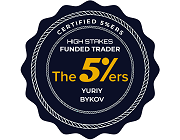Yuriy Bykov / Profil
- Informations
|
12+ années
expérience
|
12
produits
|
40
versions de démo
|
|
3
offres d’emploi
|
1
signaux
|
1
les abonnés
|

В данной статье продолжим подключить новую стратегию к созданной системе автоматической оптимизации. Посмотрим, какие изменения потребуется внести в советник создания проекта оптимизации и советники второго и третьего этапов.

В данной статье рассмотрим как нам подключить новую стратегию к созданной системе автоматической оптимизации. Посмотрим, какие советники нам понадобится создать и можно ли будет обойтись без изменений файлов библиотеки Advisor или свести необходимые изменения к минимуму.

Мы стремимся создать систему автоматической периодической оптимизации торговых стратегий, используемых в одном итоговом советнике. С развитием система становится всё более сложной, поэтому время от времени надо смотреть на неё в целом с целью выявления узких мест и неоптимальных решений.

Если мы взялись за автоматизацию проведения периодической оптимизации, то надо позаботиться и об автоматическом обновлении настроек советников, которые уже работают на торговом счёте. Также это должно позволять запускать советник в тестере стратегий и менять его настройки в рамках одного прохода.

Для дальнейшего продвижения хорошо было бы посмотреть, можем ли мы улучшить результаты, периодически выполняя повторную автоматическую оптимизацию и генерирование нового советника. Камнем преткновения во многих спорах об использовании оптимизации параметров является вопрос о том, насколько долго можно использовать полученные параметры для торговли в будущем периоде с сохранением основных показателей прибыльности и просадки на заданных уровнях. И можно ли вообще это делать?

Мы создали уже довольно много компонентов, которые помогают организовать процесс автоматической оптимизации. При создании мы придерживались традиционной цикличности: от создания минимального рабочего кода до рефакторинга и получения улучшенного кода. Пришло время заняться наведением порядка в нашей базе данных, которая тоже является ключевым компонентом в создаваемой системе.

Пока что мы рассматривали автоматизацию запуска последовательных процедур оптимизации советников исключительно в штатном тестере стратегий. Но что делать, если между такими запусками нам хотелось бы выполнить некоторую обработку уже полученных данных, используя другие средства? Попробуем добавить возможность создания новых этапов оптимизации, выполняемых программами, написанными на Python.

Продолжим автоматизировать шаги, которые ранее мы выполняли вручную. В этот раз вернёмся к автоматизации второго этапа, то есть выбора оптимальной группы одиночных экземпляров торговых стратегий, дополнив его возможностью учитывать результаты экземпляров на форвард-периоде.

Currently, our EA uses the database to obtain initialization strings for single instances of trading strategies. However, the database is quite large and contains a lot of information that is not needed for the actual EA operation. Let's try to ensure the EA's functionality without a mandatory connection to the database.

The EA under development is expected to show good results when trading with different brokers. But for now we have been using quotes from a MetaQuotes demo account to perform tests. Let's see if our EA is ready to work on a trading account with different quotes compared to those used during testing and optimization.

As we gradually approach to obtaining a ready-made EA, we need to pay attention to issues that seem secondary at the stage of testing a trading strategy, but become important when moving on to real trading.

The previously developed risk manager contained only basic functionality. Let's try to consider possible ways of its development, allowing us to improve trading results without interfering with the logic of trading strategies.
| Qualité des spécifications | 5.0 | |
| Qualité du contrôle des résultats | 5.0 | |
| Disponibilité et communication | 5.0 |
Первый этап требовал достижения прибыли 8% от начального баланса и занял немногим менее месяца.
Второй этап требовал достижения 5%, но из-за менее удачного периода затянулся почти на два месяца.
Теперь ждем активации Funded-аккаунта, которая занимает, по словам техподдержки, 24 - 48 часов


We have already implemented the first stage of the automated optimization. We perform optimization for different symbols and timeframes according to several criteria and store information about the results of each pass in the database. Now we are going to select the best groups of parameter sets from those found at the first stage.

In the EA being developed, we already have a certain mechanism for controlling drawdown. But it is probabilistic in nature, as it is based on the results of testing on historical price data. Therefore, the drawdown can sometimes exceed the maximum expected values (although with a small probability). Let's try to add a mechanism that ensures guaranteed compliance with the specified drawdown level.

To get a good EA, we need to select multiple good sets of parameters of trading strategy instances for it. This can be done manually by running optimization on different symbols and then selecting the best results. But it is better to delegate this work to the program and engage in more productive activities.

The EA development plan includes several stages with intermediate results being saved in the database. They can only be retrieved from there again as strings or numbers, not objects. So we need a way to recreate the desired objects in the EA from the strings read from the database.

Let's outline the main stages of the EA development. One of the first things to be done will be to optimize a single instance of the developed trading strategy. Let's try to collect all the necessary information about the tester passes during the optimization in one place.

As we progressed, we used more and more simultaneously running instances of trading strategies in one EA. Let's try to figure out how many instances we can get to before we hit resource limitations.